1. Catch the King Chess Materials
2. FAQ (Frequently Asked Questions)
3. Teacher & Classroom Questions
4. Introductory Email Chess (Practice Session)
5. Consultation & Tandem Chess
6. Puzzles (Math Chess & Trivia)
Paul Simon's
"Catch the King"
(Chess For Elementary Schools)
FAQ
The following questions constitute an initial list and can be modified with increased input from schools:
1. What two colours are used on a chessboard?
White & Black or Light & Dark.2. Why do most chessboards have green and white squares?
This is because it is easier to look at green for longer periods of time.- 3. Why are there red chessmen on the
demonstration board instead of white, like an
ordinary chess set?
White chessmen would be the same colour as the white squares in the background. This would make them more difficult to see, as opposed to the "red on white" or the "black on green" which is the case with the black chessmen.
4. Why are there numbers and letters along the edge of the chessboard?
The numbers & letters are used to identify the names of all the squares on the chessboard. This is known as Algebraic Notation.5. What is meant by "ranks & files"?
Ranks are the rows of squares that run horizontally and are identified by the numbers 1 through 8. Files are the columns of squares that run vertically and are identified by the letters a through h.6. Why is it important to place the white men on the 1st & 2nd rank and the black men on the 7th & 8th rank in the starting position?
The placement of the men on these ranks in the starting position is necessary in order to keep a record/score of the game and to determine the direction in which the pawns are moving. In most diagrams the white forces are set up at the bottom of the board which means that the white pawns are moving up the board toward the 8th rank and the black forces start out at the top of the board and these pawns move down the board toward the 1st rank.7. How do you remember what squares the king and queen go on in the starting position?
The king and queen are always placed beside each other with the queen going on its own colour square. The white queen goes on the white square (d1) and the black queen goes on the black square (d8).8. Does the knight capture any of the men it jumps over?
No. The knight captures like the other pieces, the way it moves. It can only capture a man that is situated on the square to which it jumps.9. Can the king ever be captured?
No! The king may never be captured. When it is attacked, or in check, it must guard against the threat by moving, capturing or blocking.10. What is a stalemate?
Stalemate occurs when one side has no legal moves and the king is not in check. When this happens the game is a tie or in chess terms, it is called a draw.11. What is the 50 move rule?
The most common application of the 50 move rule occurs when one side is left with a lone king and the opponent has a king and queen, or some other material advantage. The stronger side must checkmate in 50 moves and if this isn't accomplished the defender can then claim a draw.12. What happens when both players make the same moves over and over again?
When both players repeat the position three times the game ends in a draw.13. What is the en passant rule?

"En Passant" is a special
capture made only by the pawns. For this special capture
to take effect certain conditions must be met. To begin
with, if white were to capture en passant a white pawn
must be on the 5th rank and a black pawn on its original
square on an adjacent file.
The above diagram is an example of these conditions. The
white pawn is on "g5" and the black pawn is on
"f7". If the black pawn moves to "f5"
(f7-f5 - notice that the pawn has moved two
squares which it may only do from its
original square)...

...then white has the option of implementing the en passant capture by playing g5xf6 e.p., resulting in ...
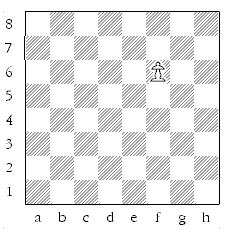
...the above position. The black pawn is removed from the board and the white pawn moves to f6. It's as if an ordinary pawn capture (g5xf6) has taken place. It is also important to remember that although the en passant capture is optional it must be made on the very next move. If this does not occur, then it is no longer possible.
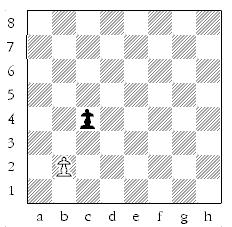
The same conditions apply when black
captures en passant. Except, of course, that a black pawn
must be on the 4th rank and a white pawn on its original
square on an adjacent file.
In the above diagram the black pawn on "c4" can
capture en passant only if the white pawn on
"b2" moves to "b4" (b2-b4).
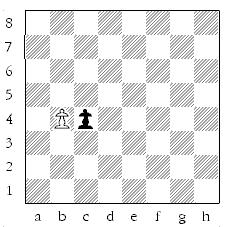
Once this has occurred, as in the above diagram, black has the option of capturing the white pawn with...
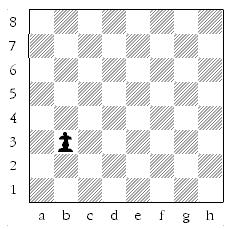
...c4xb3 e.p., leaving us with the above position.
14. What is pawn promotion?
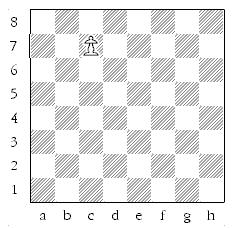
"Pawn promotion" occurs when a pawn reaches the end of the board. Since pawns can only move forward their reward for making this long journey is to become a queen, rook, bishop or knight - but not a king. It is the player's choice. After c7-c8 the white pawn becomes...
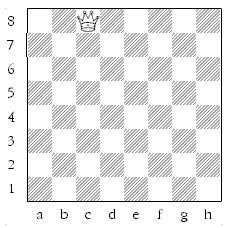
...a queen, or...
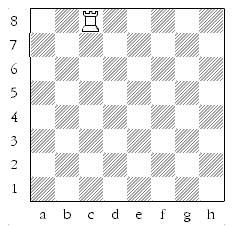
...rook, or etc.
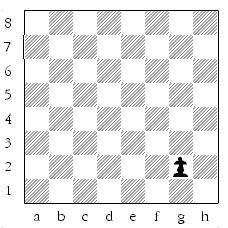
It's the same thing for black. If the pawn makes it all the way to the 1st rank by playing g2-g1, then...
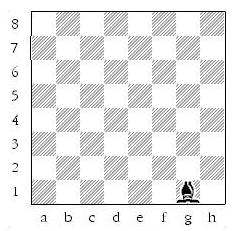
...the pawn may promote to a bishop, or...
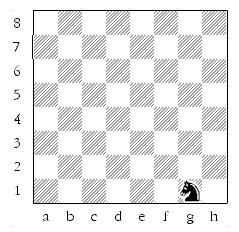
...knight, or etc.
15. What is castling?
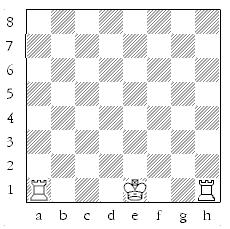
"Castling" is unique in that it is a single move that utilizes two friendly pieces, the king and one of the rooks. In the above position white has the choice of castling to the right ("short side"), or to the left ("long side"). For example, if white chooses to "castle short", first the king moves two squares to the right (e1-g1)...
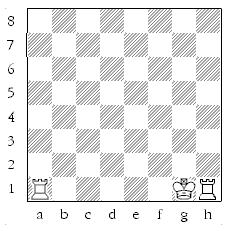
...after which the rook jumps over the king and lands on the square immediately beside the king (h1-f1)...
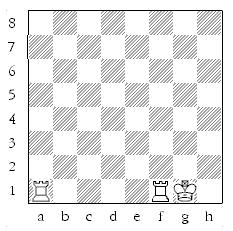
...resulting in the above final position. Since castling involves two pieces, short side is written down as "0-0". Long side castling involves the same method and it...
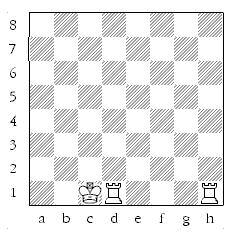
...is written as "0-0-0".
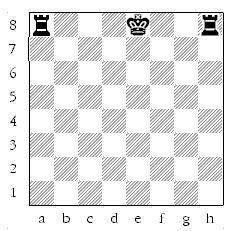
Once again it's the same procedure for black. If black chooses to castle short (0-0)...
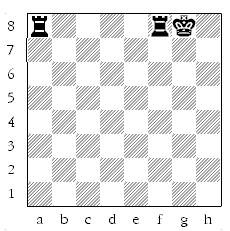
...or long (0-0-0).
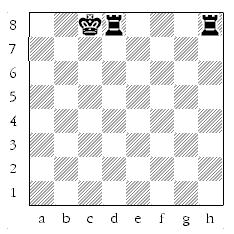
There are certain rules to castling which the players must remember. Castling is illegal if:
there are pieces between the king and rook;
either king or rook has previously moved;
the king is in check, moving into check or moving through check.



































































